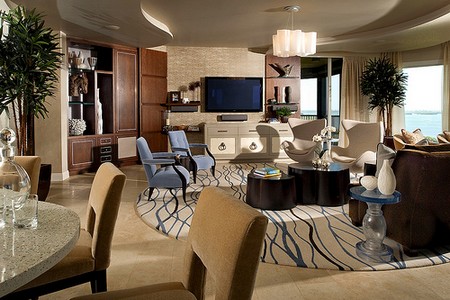Best Way to Create an Allergy-Free Home with the right Furnishings and Fixtures
Choosing furnishings and fixtures for the home is a very individual affair but more than personal taste is involved -your choice affects the level of allergens and irritants in the home.
Soft furnishings
Leather or vinyl is the preferred covering for soft furnishings, as dust mites find it inhospitable, while fabric-upholstered furniture provides the ideal home for dust mites. Consider replacing fabric upholstery with leather or vinyl, or other hard-surface materials, such as wood or plastic – or at least reduce the number of soft furnishings you have in your home.
Leather or vinyl only needs wiping over with a damp cloth weekly to keep it clean of dust and mites, while controlling mites in fabric-upholstered furnishings is far more difficult. Several approaches are used to try to do this, or to neutralize or remove the allergen, and these also apply to other mite reservoirs, such as carpets.
Acaricides
These mite-killing chemicals penetrate only the uppermost layers of fabric, so mites deeper down survive – and the mite allergen still needs to be removed afterwards by vacuuming. The most-researched acaricide, benzyl benzoate, may persist for up to a year after application, although most studies suggest it should be reapplied several times a year. One study suggests acaricides may reduce symptoms of mite-related rhinitis, but there is a lack of evidence that they are generally beneficial. As no long-term safety studies have been done in the home, you may not want to use acaricides in children’s rooms.
Denaturing agent Tannic acid alters the structure of all allergens, (denatures them) including pollen and dander, as well as mite allergen, so that they no longer cause an allergic reaction. It needs applying three to four times a year but may discolour pale fabrics or carpets. It is probably harmless to people and animals.
Steam treatment
Mites near the surface are killed by steam, although those deeper down in soft furnishings (and mattresses) are likely to be unaffected. Ask for independent proof that the steam treatment is sufficiently hot for long enough to denature mite allergen, as not all steam treatments achieve this. The dead mites and allergen are removed afterwards by vacuuming. Steam cleaning probably needs to be done every three months.
Wooden furniture, simply made, with the minimum of detailing where dust can collect, and upholstered in leather, makes the management of dust-mite allergy far easier.
Vacuuming
Domestic vacuum cleaners, even HEPA-filtered models, are not powerful enough to clean fabric-covered furnishings sufficiently of mites, which cling to the fabric, or of mite allergen to justify the effort involved.
Heat treatment
This treatment kills mites and denatures mite allergen. The whole sofa, couch, or chair, slightly dampened with a tannic acid solution, is heated to about 100°C/212°F inside a tent-like envelope. Contractors recommend annual treatment. It is also suitable for mattresses, bedding, soft cushions, and curtains.
Liquid nitrogen
This freezes mites to death and loosens the allergen-containing dirt, which can then be removed with a vacuum cleaner It must be applied by a contractor once or twice a year It does not leave chemical residues and is safe.
Board-based furniture
Various forms of “board” – an inexpensive wood-based product -include laminated board, chipboard (particle board), hardboard, and medium-density fibreboard (MDF). It is often used in flooring, roofing, shelving, and furniture, and is composed of wood components bonded with glue or resin made with formaldehyde. Some, such as MDF, contain much higher levels of formaldehyde than others. The glue or resin gives off (out-gases) formaldehyde, a colourless, pungent gas. Some people with rhinitis or asthma find that formaldehyde worsens their allergic symptoms. The amount of formaldehyde out-gassed is greatest when the board is new, in the first few weeks to several months, but then gradually decreases.
Choosing new furniture
Nearly all modern, mass-produced wood furniture, even that labelled “solid wood”, contains some board. This includes veneered furniture, in which a layer of fine wood covers a less-expensive board carcass.
When buying new board-based furniture, including kitchen or bathroom cabinets, try to choose furniture made from board encased in a plastic laminate, which has the effect of minimizing formaldehyde emission.You may want to consider airing new products for a week or two, in a dry place under cover so that they do not warp, to make sure the peak period for formaldehyde out-gassing has passed.
Look for exposed areas of board where the laminate has not covered the carcass; these are the areas where formaldehyde will most readily out-gas. Painting any exposed board with several layers of paint or varnish is said by some people to minimize the emission of formaldehyde gas.
Because of the formaldehyde issue, you may want to consider using as much solid wood furniture as possible, despite its extra expense. Softwood, metal, or glass can all be used for shelving. A few people find that the terpene vapours given off by softwoods worsen allergic symptoms.
Categories
Advertisements
Recent Articles
 How to Understand Bed Sizes – A Small Guide
How to Understand Bed Sizes – A Small Guide How to Select Some Must Have Kitchen Accessories
How to Select Some Must Have Kitchen Accessories Best Way to Change a Car Tire
Best Way to Change a Car Tire Best Way to Write an Affirmation
Best Way to Write an Affirmation Best Way to Take Charge of Your Financial Life
Best Way to Take Charge of Your Financial Life Best Way to Survive a Party When You Don’t Know Anyone
Best Way to Survive a Party When You Don’t Know Anyone Best Way to Stop Self Sabotaging Yourself
Best Way to Stop Self Sabotaging Yourself Best Way to Start Journal Writing
Best Way to Start Journal Writing Best Way to Speak with a Powerful Voice
Best Way to Speak with a Powerful Voice Best Way to Simplify Your Life
Best Way to Simplify Your Life Best Way to Respond to a Put-Down
Best Way to Respond to a Put-Down Best Way to Reduce Acne Breakouts
Best Way to Reduce Acne Breakouts Best Way to Recover from Dining Disasters
Best Way to Recover from Dining Disasters Best Way to Quit Your Job Gracefully
Best Way to Quit Your Job Gracefully Best Way to Make Your Own Website
Best Way to Make Your Own Website




Leave a Reply